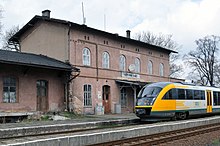Krzewina (Bogatynia)
| Krzewina | ||
|---|---|---|

|
|
|
| Basic data | ||
| State : | Poland | |
| Voivodeship : | Lower Silesia | |
| Powiat : | Zgorzelec | |
| Gmina : | Bogatynia | |
| Geographic location : | 51 ° 1 ' N , 14 ° 57' E | |
| Height : | 260 m npm | |
| Residents : | 220 | |
| Telephone code : | (+48) 75 | |
| License plate : | DZG | |
| Economy and Transport | ||
| Next international airport : | Dresden | |
| Wroclaw | ||
Krzewina [ kʃɛˈvʲina ] (German Grunau ) is a village in the municipality of Bogatynia (Reichenau) in Poland . It is located on the Lusatian Neisse opposite the city of Ostritz .
The Krzewina Zgorzelecka station outside the village is the station of the city of Ostritz, whose name it also bore until 1945. Passenger trains of the East German Railway (ODEG) stop here , the Polish State Railways (PKP) have stopped passenger traffic. Since 1989 there has been a border crossing for pedestrians and cyclists between the two places .
history
The first news about Grunau comes from the year 1294. The village, which was owned by the von Grunau family until 1380, finally came to the St. Marienthal monastery in 1396 after they died out .
Grunau was a Catholic parish village, to which Schönfeld (Lutogniewice), Trattlau (Kostrzyna), Wanscha (Spytków) and Reutnitz (Ręczyn) were parishes. In 1739 a new church was built, for which the court painter Gabriel Ambrosius Donath of the Electorate of Saxony painted the altarpiece. The parish found the portrait of the beheading of John the Baptist too dark, so in 1871 they had it replaced by another portrait of this saint made by a painter from Ostritz.
In 1857 an orphanage was built in the Grunau monastery , which moved into the monastery in 1866. In its place, the Albertverein built a hospital that served as a military hospital during the First World War . With the Neißetalbahn between Nickrisch (Hagenwerder) and Zittau , inaugurated on October 15, 1875 , Grunau received a railway connection .
In the time of National Socialism , a Reichsarbeitsdienstlager was built in the place . In 1933 there were 498 inhabitants in Grunau, in 1939 there were 486.
Until 1945, the village belonged to the Zittau administration in Saxony . As a result of the demarcation along the Oder and Neisse rivers, the Upper Lusatian village was expelled from Poland and the German residents.
After the part of the Neißetalbahn east of the Neisse was handed over to the PKP in 1946, passenger traffic, which had been resumed on September 9, 1945, was stopped. In 1948 the line was restarted, with German passenger trains having to drive through the Polish area with the doors closed and the curtains drawn. Since 1950, a stop at the Krzewina Zgorzelecka station has been made possible again. For this purpose, the Neisse bridge between Ostritz and the train station, which is about 100 meters from the Polish bank, was opened for boarding and alighting during the train times and the process was monitored by the Polish border guards. There was no border crossing. In 1957, the Polish State Railways opened the new Zawidów – Bogatynia line.
Development of the population
|
|
|
Sons and daughters of the church
- Gabriel Ambrosius Donath (1684–1760), court painter to August the Strong


